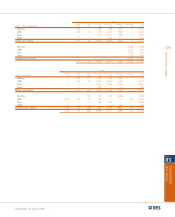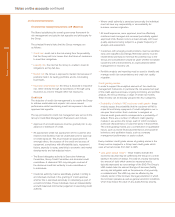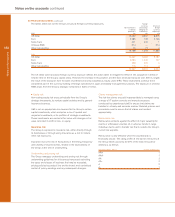RBS 2005 Annual Report Download - page 186
Download and view the complete annual report
Please find page 186 of the 2005 RBS annual report below. You can navigate through the pages in the report by either clicking on the pages listed below, or by using the keyword search tool below to find specific information within the annual report.
184
Notes on the accounts
34 Financial instruments
Notes on the accounts continued
Financial risk management policies and objectives
The Board establishes the overall governance framework for
risk management and sets the risk appetite and philosophy for
the Group.
The principal financial risks that the Group manages are
as follows:
•Credit risk: credit risk is the risk arising from the possibility
that the Group will incur losses from the failure of customers
to meet their obligations.
•Liquidity risk: the risk that the Group is unable to meet its’
obligations as they fall due.
•Market risk: the Group is exposed to market risk because of
positions held in its trading portfolios and its non-trading
businesses.
•Insurance underwriting risk: the Group is exposed to insurance
risk, either directly through its businesses or through using
insurance as a tool to mitigate other risk exposures.
Credit risk
The objective of credit risk management is to enable the Group
to achieve sustainable and superior risk versus reward
performance whilst maintaining credit risk exposure in line with
approved risk appetite.
The key principles for credit risk management are set out in the
Group’s Credit Risk Management Framework and include:
•Approval of all credit exposure must be granted prior to any
advance or extension of credit.
•An appropriate credit risk assessment of the customer and
related credit facilities must be undertaken prior to approval
of credit exposure. This must include an assessment of,
amongst others, the purpose of the credit and sources of
repayment, compliance with affordability tests, repayment
history, capacity to repay, sensitivity to economic and market
developments and risk-adjusted return.
•The Board delegates authority to Executive Advances
Committee, Group Credit Committee and divisional credit
committees. A divisional CEO may delegate a subset of
the divisional credit risk authority to sub-committees or
to individuals.
•Credit risk authority must be specifically granted in writing to
all individuals involved in the granting of credit approval,
whether this is exercised personally or collectively as part of
a credit committee. These individuals must act independently
and with balanced commercial judgement in exercising credit
authority.
•Where credit authority is exercised personally, the individual
must not have any responsibility or accountability for
business revenue origination.
•All credit exposures, once approved, must be effectively
monitored and managed and reviewed periodically against
approved limits. Review occurs at least annually, with lower
quality exposures being subject to a greater frequency of
analysis and assessment.
•Customers with emerging credit problems must be identified
early and classified accordingly. Remedial actions must be
implemented promptly to minimise the potential loss to the
Group and consideration should be given whether to transfer
customers with credit problems to a specialised problem
management or recovery unit.
•Portfolio analysis and reporting must be used to identify and
manage credit risk concentrations and credit risk quality
migration.
Credit grading models
In order to support the analytical elements of the credit risk
management framework, in particular the risk assessment part
of the credit approval process, ongoing monitoring and portfolio
analysis, the Group employs a range of credit risk models.
These models can be broadly grouped into four categories.
•Probability of default (“PD”)/customer credit grade – these
models assess the probability that the customer will fail to
make full and timely repayment of credit obligations over a
one year time horizon. Each customer is assigned an
internal credit grade which corresponds to a probability of
default. There are a number of different credit grading
models in use across the Group, each of which considers
particular characteristics of customer types in that portfolio.
The credit grading models use a combination of quantitative
inputs, such as recent financial performance and customer
behaviour, and qualitative inputs, such as company
management performance or sector outlook.
Every customer credit grade across all grading scales in the
Group can be mapped to a Group level credit grade which
uses a five band scale from AQ1 to AQ5.
•Loss given default (“LGD”) – these models estimate the
economic loss that may be suffered by the Group on a credit
facility in the event of default. The LGD of a facility represents
the amount of debt which cannot be recovered and is
typically expressed as a percentage of the EAD. The Group's
LGD models take into account the type of borrower, facility
and any risk mitigation such as the presence of any security
or collateral held. The LGD may also be affected by the
industry sector of the borrower, the legal jurisdiction in which
the borrower operates as well as general economic conditions
which may impact the value of any assets held as security.
























